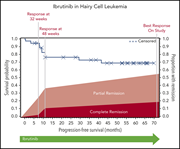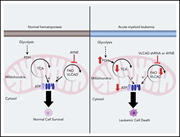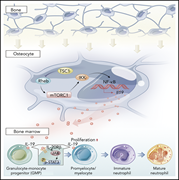Issue Archive
Table of Contents
BLOOD COMMENTARIES
CLINICAL TRIALS AND OBSERVATIONS
Phase 2 study of ibrutinib in classic and variant hairy cell leukemia
Clinical Trials & Observations
Treatment of relapsed/refractory hairy cell leukemia (R/R HCL) is challenging. Rogers and colleagues demonstrate efficacy of ibrutinib in a phase 2 study of 37 patients with R/R HCL, with 36-month progression-free and overall survival estimates of 73% and 85%, respectively. Interestingly, response was not predicted by loss of pERK phosphorylation, suggesting that the impact of ibrutinib may not be mediated solely by Bruton tyrosine kinase inhibition.
IMMUNOBIOLOGY AND IMMUNOTHERAPY
Molecular bases for the association of FHR-1 with atypical hemolytic uremic syndrome and other diseases
Martin Merinero et al delineate the molecular basis for association of mutant factor H–related protein 1 (FHR-1) with atypical hemolytic uremic syndrome (aHUS) and elucidate the interactions between factor H (CFH) and FHR-1 that regulate complement activation. CFH has a C-terminal domain that binds to cells and an N-terminal domain that facilitates degradation of activated complement. FHR-1 lacks complement-degrading activity and binds poorly to cell membranes; rare mutations allow increased cell surface binding and increase recruitment of complement C3, leading to increases in complement activation and aHUS.
LYMPHOID NEOPLASIA
BH3 profiling identifies ruxolitinib as a promising partner for venetoclax to treat T-cell prolymphocytic leukemia
Preexisting and treatment-emergent autoimmune cytopenias in patients with CLL treated with targeted drugs
Clinical Trials & Observations
Autoimmune hemolytic anemia or thrombocytopenia occurs in 5% to 9% of patients with chronic lymphocytic leukemia (CLL). Vitale and colleagues examined the impact of ibrutinib, idelalisib, and venetoclax on preexisting or emergent autoimmune cytopenias (AICs) in a retrospective analysis of 572 patients with CLL. Preexisting AIC active at the initiation of targeted drugs has a high rate of resolution, while emergent AIC during therapy is rare and largely associated with CLL with unfavorable biological features.
MYELOID NEOPLASIA
Very long chain fatty acid metabolism is required in acute myeloid leukemia
Acute myeloid leukemia (AML) cells depend on oxidative phosphorylation and fatty acid oxidation (FAO) for survival. Tcheng et al used public databases to assess differential FAO enzyme expression in normal and AML cells and identify overexpression of very long–chain acyl coenzyme A dehydrogenase (VLCAD) in AML cells. Genetic or pharmacologic inhibition of VLCAD decreases AML cell growth by interfering with mitochondrial respiration, thereby identifying a possible targeted therapeutic pathway for treatment of AML.
PHAGOCYTES, GRANULOCYTES, AND MYELOPOIESIS
Osteocytes regulate neutrophil development through IL-19: a potent cytokine for neutropenia treatment
Xiao et al identify interleukin-19 (IL-19) produced by osteocytes as a regulator of neutrophil production. Constitutive activation of mechanistic target of rapamycin complex (mTORC1) signaling in osteocytes increases IL-19 levels and expands neutrophil numbers. Low-dose IL-19 potently reverses radiation-, chemotherapy-, and chloramphenicol-induced neutropenia, suggesting that it is a potential novel and effective new agent for treatment of neutropenia.
RED CELLS, IRON, AND ERYTHROPOIESIS
The equilibrative nucleoside transporter ENT1 is critical for nucleotide homeostasis and optimal erythropoiesis
THROMBOSIS AND HEMOSTASIS
Annual incidence and severity of acute episodes in hereditary thrombotic thrombocytopenic purpura
Clinical Trials & Observations
Tarasco and colleagues report prospective data for 87 patients with hereditary thrombotic thrombocytopenic purpura (TTP). The data have some surprises. Although von Willebrand factor levels rise with age, this did not lead to increased acute episodes; in fact, the majority of episodes occurred in patients less than 18 years old. In addition, prophylactic plasma as currently administered every 2 to 3 weeks does not reduce episodes, suggesting that plasma (or recombinant ADAMTS13, when available) should probably be administered weekly.
LETTER TO BLOOD
HLA class I allele–lacking leukocytes predict rare clonal evolution to MDS/AML in patients with acquired aplastic anemia
-
Cover Image
Cover Image
![issue cover]()
Bone marrow core biopsy from a patient with hairy cell leukemia variant after 48 weeks of treatment with ibrutinib. Leukemia cells identified by PAX5 (brown nuclear staining) do not have phospho-ERK expression (red cytoplasmic staining). See the article by Rogers et al on page 3473.
- PDF Icon Front MatterFront Matter
- PDF Icon Table of ContentsTable of Contents
- PDF Icon Back MatterBack Matter
- PDF Icon Editorial BoardEditorial Board
Advertisement intended for health care professionals
Email alerts
Advertisement intended for health care professionals











Ibrutinib: another string to its bow
Clinical Trials & Observations